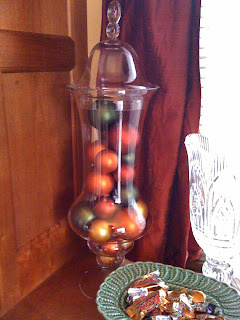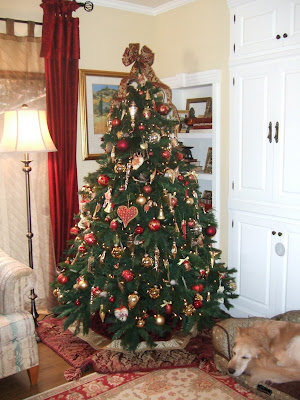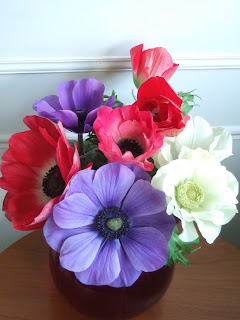The only way most people recognize their limits is by trespassing on them.
Wednesday, December 29, 2010
Monday, December 27, 2010
Floriography / 花言葉
Language of Flowers
For centuries, flowers and various plants have given pleasure to many as their beauty and fragrances tap into human senses and bring meaning to our lives. The language of flowers spans the world from Greece and Turkey to the Aztecs of South and Central America. In the 1600's flowers were used in Turkey to send messages of great importance through a seemingly harmless bouquet. This language gained popularity among young lovers as it enabled them to convey messages to each other without having to write or speak.
 |
| tussie mussie |
Flowers have always held meaning but during the Victorian era this became a form of language called "floriography". Floriography was a means of communication through flowers. This language was used to send coded messages to and from lovers in both gardens and in bouquets, allowing individuals to express feelings which otherwise could not be spoken. Considered both a universal and secrete language, it has fluctuated in popularity throughout the ages. Dozens of floral dictionaries were published listing the meanings flowers and herbs. The meanings were adapted from many different places including mythology, ancient texts and of course, religion. The most popular method of floriography was used in the Tussie-Mussie, a small cluster of flowers in a round bouquet that was given for any occasion. Flowers have always held religious and symbolic meaning and still do today.
花言葉
花言葉(はなことば、floriography、language of flowers)は、草花にあてはめられた合い言葉や符牒(符丁)の事。草花の色から受ける生理的効果や作用、草花が持つ背丈の高低・刺の有無・成長や香りなどから受ける印象・性質を言葉に置き換える事により、様々な種類の草花や花飾り・花束を通じて、直接言葉を交わさずとも互いの意志疎通や感情を伝える事の出来る手段として生まれた。花詞の文字を当てる場合もある。
英国では19 世紀のヴィクトリア朝時代に流行し、定着した。当時の花言葉が持っていたそれぞれの細やかな心情は現在には正確に伝えられておらず、数多くの花言葉が持っていた特別な意味は忘れ去られてしまった。しかし、赤いバラは情熱的で甘美な愛情、桃色のバラは病気の回復、白いバラは美徳や純潔、黄色いバラは友愛や献身をそれぞれ示すというように、現代においても花言葉の意味は草花の姿が語る印象と結び付けられて残っている。
英国では19 世紀のヴィクトリア朝時代に流行し、定着した。当時の花言葉が持っていたそれぞれの細やかな心情は現在には正確に伝えられておらず、数多くの花言葉が持っていた特別な意味は忘れ去られてしまった。しかし、赤いバラは情熱的で甘美な愛情、桃色のバラは病気の回復、白いバラは美徳や純潔、黄色いバラは友愛や献身をそれぞれ示すというように、現代においても花言葉の意味は草花の姿が語る印象と結び付けられて残っている。
 |
花言葉は、17世紀にオスマン帝国(トルコ)の首都イスタンブル(コンスタンティノープル)で付けられ始めるようになった とされる。当時のイスタンブルの社会では、チューリップをはじめ様々な花が愛好されていた。
花言葉はヨーロッパには、二人の人間によって紹介された。一人は当時、英国のコンスタンティノープル駐在大使夫人であったメアリー・W・モンタ ギュー(Mary Wortley Montagu, 1689年 - 1762 年)で、彼女によって1717年に英国へ伝えられた。もう一人はヨーロッパからアジア、アフリカなどを旅行してまわり、トルコには4年間滞在したオーブ リー・ド・ラ・モトレイ(Aubry de La Mottraye, 1674年 - 1743年)で、1727 年にスウェーデン王カール12世(1682年6 月17日 - 1718年11月30日)の宮廷に招かれた際に紹介した。
花言葉はヨーロッパには、二人の人間によって紹介された。一人は当時、英国のコンスタンティノープル駐在大使夫人であったメアリー・W・モンタ ギュー(Mary Wortley Montagu, 1689年 - 1762 年)で、彼女によって1717年に英国へ伝えられた。もう一人はヨーロッパからアジア、アフリカなどを旅行してまわり、トルコには4年間滞在したオーブ リー・ド・ラ・モトレイ(Aubry de La Mottraye, 1674年 - 1743年)で、1727 年にスウェーデン王カール12世(1682年6 月17日 - 1718年11月30日)の宮廷に招かれた際に紹介した。
その後、1819年12月にシャルロット・ド・ラトゥール(Charlotte de Latour)が著わした Le Langage des Fleurs (『花の言葉』)により、フランスでは1810年から1850 年にかけて流行した。これをはじめとして、英国では1820年から1880 年のヴィクトリア朝時代、アメリカでは1830年から1850年代に流行し、さらにベルギーやドイツなどの他のヨーロッパ諸国や南アメリカへと広まっていって、現代のように世界的に広く知られるに至った。
Quote of the Day
Living apart and at peace with myself, I came to realize more vividly the meaning of the doctrine of acceptance. To refrain from giving advice, to refrain from meddling in the affairs of others, to refrain, even though the motives be the highest, from tampering with another's way of life - so simple, yet so difficult for an active spirit.
Flower of the Week / 今週の花
Anemone
Anemone is a genus of about 120 species of flowering plants in the buttercup family Ranunculaceae in the north and south temperate zones. They are closely related to Pasque flowers (Pulsatilla) and Hepaticas (Hepatica); some botanists include both of these genera within Anemone. Greek anemōnē means "daughter of the wind", from ánemos "wind" + feminine patronymic suffix -ōnē.
Anemone have basal leaves with long leaf-stems that can be upright or prostrate. Leaves are simple or compound with lobed, parted, or undivided leaf blades. The leaf margins are toothed or entire. Flowers with 4-27 sepals are produced singly, in cymes of 2-9 flowers, or in umbels, above a cluster of leaf- or sepal-like bracts. Sepals may be any color. They are bisexual 10 to 200 stamens and have many simple pistils. The pistils have one ovule. The flowers have nectaries, but petals are missing in the majority of species.
Anemone have basal leaves with long leaf-stems that can be upright or prostrate. Leaves are simple or compound with lobed, parted, or undivided leaf blades. The leaf margins are toothed or entire. Flowers with 4-27 sepals are produced singly, in cymes of 2-9 flowers, or in umbels, above a cluster of leaf- or sepal-like bracts. Sepals may be any color. They are bisexual 10 to 200 stamens and have many simple pistils. The pistils have one ovule. The flowers have nectaries, but petals are missing in the majority of species.
Floriography - Forsaken, sickness, unfading love
アネモネ
アネモネ(学名:Anemone coronaria)はキンポウゲ科イチリンソウ属の多年草。和名はボタンイチゲ(牡丹一華)、ハナイチゲ(花一華)、ベニバナオキナグサ(紅花翁草)。または、アネモネ属(Anemone)の総称を表すこともある。
語源はギリシア語で「風」を意味するΆνεμος (anemos)から。ギリシア神話中に、美少年アドニスが流した血よりこの植物が産まれたとする伝説があり、稀にアドニスと呼ぶこともある。なお、adonisはフクジュソウ属の学名である。
語源はギリシア語で「風」を意味するΆνεμος (anemos)から。ギリシア神話中に、美少年アドニスが流した血よりこの植物が産まれたとする伝説があり、稀にアドニスと呼ぶこともある。なお、adonisはフクジュソウ属の学名である。
花言葉 - はかない希望 恋の苦しみ 真
Christmas Past
今年のクリスマスはバタバタしたクリスマスでした。家族と過ごせるクリスマスが一番です。毎年ホワイトクリスマスを願っているのですが、なかなかならないです。でも今年は25日に雪が降ったのでま~いいかなみたいな・・・ 東北の方に住んでいる人がうらやましい。涙 今月はクリスマスの飾りつけなどを紹介する予定でしたがもう過ぎ てしまったので写真だけアップします。皆さんも参考にして来年飾りつけをしてみて下さいw
 |
 |
 |
 |
 |
 |
Christmas has past... "Guiseppe Martini said that 'Family is the Country of the Heart.' We spend so much of our lives in exile, so on the holidays we make the pilgrimage home to the nation of our heart."
"Is there such a thing as the perfect holiday? All holidays are about the same thing, connecting to the people that care about you. Feeling like... you are a part of something, a family, a community, a culture..." The true meaning of Christmas, something to think about. Explore more into details another time.
Wednesday, December 22, 2010
Christmas Greenery / クリスマスの常緑の葉
Evergreen
 |
| コヒバ |
欧米ではクリスマスの時期にモミを飾ることが多いんですが、日本ではモミが手に入らないのでヒバで部屋を飾ってみてはいかがでしょうか? やっぱり本物の常緑植物をクリスマスに飾ると違う気分になりますね。ここでちょっとクリスマスの植物について。
常緑の葉は「永遠の生命」を意味します。セイヨウヒイラギは、ゲルマン人などに信仰されていたドルイト教で、冬の間の樹木の精の避難所と考えられていました。クリスマスに飾られる常緑の葉の代表はヒイラギ。ただし、セイヨウヒイラギ(モチノキ科)です。残念ながら、園内には、在来種のヒイラギ、ヒイラギモクセイ(モクセイ科)のみが植栽されております。常緑で、葉に棘という意味では、ヒイラギナンテン(メギ科)も挙げられるかもしれません。
 |
| ポインセチア |
・赤い色は魔除けの色ですポインセチアは赤い色に魔除けの力を期待して、この季節に飾られます。メキシコ西部原産です。
 |
| ヒイラギ |
・キリスト教と結びついた植物がありますゲッケイジュも窓に飾られます。キリスト降臨の目印との思いが込められています。日本の門松に匹敵する発想でしょうか。西洋ヒイラギとキヅタ(フユヅタ冬蔦)が飾られることもあります。多くはリースにして玄関に飾られます。
 |
| クリスマス・カクタス |
・クリスマスの季節に咲くことに由来する植物もありますキリスト降誕の時、プレゼントを用意できない貧しい羊飼いの娘のために、天使がキリストに捧げる花として咲かせたのがクリスマス・ローズと言われています。シャコバサボテンを英名でクリスマス・カクタスと言います。ブラジルリオデジャネイロ州オルガン山の原産で、クリスマスの頃に花を咲かせます。
Stollen / シュトーレン
シュトーレン
 |
| 今年のシュトーレン / This years Stollen |
シュトレンは元々ザクセン州の州都ドレスデン市でクリスマス時期に焼かれる郷土菓子でしたが、今やドイツを代表するお菓子として、クリスマス時期になると ドイツ中のケーキ屋さんパン屋さんで焼かれています。 しかしながら現在では、ドイツのほとんどのパン屋が、シュトレンは手間隙かかるので大変だ、いうことで、工場で出来上がった材料をただ混ぜて焼いて売る、 という風になってきています。
シュトレンは、一般的にクリストシュトレン(Christstollen)、ヴァイナハツシュトレン(Weihnachtsstollen)などと呼ばれ ており、その歴史はザクセン地方で、クリストブロート(Christbrot)、シュトリーツェル、シュトロッツェル、シュトルッツェルなどと呼ばれてい た1329年にさかのぼります。
この地域の方言から、シュトーレまたはシュトーレンと呼ばれていたようです。白い粉砂糖に包まれたこのパンは、キリスト誕生の「むつきに包まれた子供」の 象徴のようです。
1474年、ドレスデンホフのバートロモイス病院(Bartholomaeus-Hospital)の診療費のため、精進食としてあったことが知られてい ます。当時は、小麦粉、水、酵母、少々の油で作られており、バターの使用は禁止されていました。そのため味気がなく、1450年に、ザクセン地方のエーン スト選帝候と兄弟のアルベルトが、ローマのニコラス5世にバターの使用願いを提出し、1491年にイノセンツ8世より許可を得たことが、歴史上ブタ-ブ リーフ(Butterbiref)として知られています。
また、ドイツで一番古い1434年からあるクリスマス市場の、ドレスデンのシュトリ-ツェル市場(Striezelmarkt)でシュトレンがシュトリー ツェルという名であったことも知られています。これが今日、名称保護となっているドレスナーシュトレンの最初であったようです。
1560年には、シュトレンパン職人が、クリスマス市場でシュトレンを1~2個売っていました。
その後、1730年に王の命令に応じて、ドレスデンで8人のマイスターと8人の職人が、長さ1,5メートル、重さ1,8トンの巨大なシュトレンを作り、城 に運びました。このことから、現在ドレスデンでは、毎年第2アドヴェントの日曜日に、巨大なシュトレンを作り、シュトレン祭りが開催されています。
この地域の方言から、シュトーレまたはシュトーレンと呼ばれていたようです。白い粉砂糖に包まれたこのパンは、キリスト誕生の「むつきに包まれた子供」の 象徴のようです。
1474年、ドレスデンホフのバートロモイス病院(Bartholomaeus-Hospital)の診療費のため、精進食としてあったことが知られてい ます。当時は、小麦粉、水、酵母、少々の油で作られており、バターの使用は禁止されていました。そのため味気がなく、1450年に、ザクセン地方のエーン スト選帝候と兄弟のアルベルトが、ローマのニコラス5世にバターの使用願いを提出し、1491年にイノセンツ8世より許可を得たことが、歴史上ブタ-ブ リーフ(Butterbiref)として知られています。
また、ドイツで一番古い1434年からあるクリスマス市場の、ドレスデンのシュトリ-ツェル市場(Striezelmarkt)でシュトレンがシュトリー ツェルという名であったことも知られています。これが今日、名称保護となっているドレスナーシュトレンの最初であったようです。
1560年には、シュトレンパン職人が、クリスマス市場でシュトレンを1~2個売っていました。
その後、1730年に王の命令に応じて、ドレスデンで8人のマイスターと8人の職人が、長さ1,5メートル、重さ1,8トンの巨大なシュトレンを作り、城 に運びました。このことから、現在ドレスデンでは、毎年第2アドヴェントの日曜日に、巨大なシュトレンを作り、シュトレン祭りが開催されています。
Stollen
 |
| Traditional Stollen |
A Stollen is a loaf-shaped cake containing dried fruit, and covered with sugar, powdered sugar or icing. The cake is usually made with chopped candied fruit and/or dried fruit, nuts and spices. Stollen is a traditional German cake, usually eaten during the Christmas season, when called Weihnachtsstollen or Christstollen. The old name Striezel came from Strüzel or Stroczel, "awaken" (Old Prussian: troskeilis), which came to mean "early-baked loaf of bread". The shape of the cake was originally meant to represent the baby Jesus wrapped in swaddling clothes.
The early Stollen was a different pastry, the ingredients were very different - flour, oats and water.
As a Christmas pastry, Stollen was baked for the first time at the Saxon Royal Court in 1427, and was made with flour, yeast, oil and water.
The Advent season was a time of fasting, and bakers were not allowed to use butter, only oil, and the cake was tasteless and hard.
In the 15th century, in medieval Saxony (a region in the eastern part of Germany, north of Bavaria and south of Brandenburg), the Prince Elector Ernst (1441 - 1486) and his brother Duke Albrecht (1443 –1500) decided to remedy this by writing to the Pope in Rome. The Saxon bakers needed to use butter, as oil in Saxony was expensive and hard to come by, and had to be made from turnips, which was unhealthy.
Pope Nicholas V (1397 – 1455), in 1450 denied the first appeal. Five popes died until finally, Pope Innocent VIII, (1432 – 1492) in 1490 sent a letter to the Prince, known as the "Butter-Letter" which granted the use of butter (without having to pay a fine) - but only for the Prince-Elector and his family and household.
Others were also permitted to use butter, but with the condition of having to pay annually 1/20th of a gold Gulden to support the building of the Freiburg Minster. The ban on butter was removed when Saxony became Protestant.
Over the centuries, the cake changed from being a simple, fairly tasteless "bread" to a sweeter cake with richer ingredients, such as marzipan, although the traditional Stollen is not as sweet, light and airy as the copies made around the world.
Sunday, December 19, 2010
Christmas Tree Origin / クリスマスツリー由来
この時期になるといつも心温かくなります。何故か子供みたいにウキウキするんだよね~。でも悪くないと思うw 英語ではこの時期を"Time of giving"とよく言います、なので人を助ける、寄付をするなど自分で出来ることをしています。良く言葉では説明できないんですがクリスマスの時期は人のよいところをすごく引き出してくれる気がします。今日はクリスマスツリーの由来についてちょっと。
 |
| 今年のツリー |
クリスマスツリーをクリスマスに飾る風習が最初に記録されたのは1419年、ドイツのフライブルクという町 で。パン職人の信心会が聖霊救貧院にツリーを飾ったのが最初といわれています1600年代にはドイツ各地で記録が残されています。ベルリンには1800 年頃にツリーが伝わり、イギリスへは19世紀に伝わっています。そんなに古いことではありませんね。アメリカ合衆国で最初のツリーはドイツ移民によって 1746年に飾られました。やはりドイツがクリスマスツリー発祥の地ですね。
 |
| Victorian Christmas |
厳しいヨーロッパの冬は一面真っ白な雪に覆われ、その中でも葉を失わない常緑樹は、永遠の命の象徴とされ、尊ばれました。 ドイツ地方の信仰ではそんなもみの木に花や食べ物を飾って、木に宿る小人がとどまって力を与えてくれるというものがありました。また、宗教改革で知れるマルチン.ルターが礼拝の帰りに常緑樹の間にきらめく星の美しさに心を打たれ、子供たちのために再現しようと家の中にもみの木を持ち込み、火のついたろうそくを飾ったことがイルミネーションの由来と言われています。
The origin of the Christmas tree is obscured by uncertainties of oral histories of pre-literate European and Asian cultures. For example, according to Christian lore, the Christmas tree is associated with St Boniface and the German town of Geismar. Sometime in St Boniface's lifetime (c. 672-754) he cut down the tree of Thor in order to disprove the legitimacy of the Norse gods to the local German tribe. St. Boniface saw a fir tree growing in the roots of the old oak.
The custom of erecting a Christmas Tree can be historically traced to 15th century Livonia (present-day Estonia and Latvia) and 16th century Northern Germany. According to the first documented uses of a Christmas tree in Estonia, in 1441, 1442, and 1514 the Brotherhood of the Blackheads erected a tree for the holidays in their brotherhood house in Reval (now Tallinn). At the last night of the celebrations leading up to the holidays, the tree was taken to the Town Hall Square where the members of the brotherhood danced around it. In 1584, the pastor and chronicler Balthasar Russow wrote of an established tradition of setting up a decorated spruce at the market square where the young men “went with a flock of maidens and women, first sang and danced there and then set the tree aflame.” In that period, the guilds started erecting Christmas trees in front of their guildhalls: Ingeborg Weber-Kellermann (Marburg professor of European ethnology) found a Bremen guild chronicle of 1570 which reports how a small tree was decorated with "apples, nuts, dates, pretzels and paper flowers" and erected in the guild-house, for the benefit of the guild members' children, who collected the dainties on Christmas Day.
If you'd like to learn more about the history of Christmas trees, check out http://billpetro.com/history-of-christmas-tree
Saturday, December 18, 2010
Chrysanthemum Present Floral Arrangement
I used different colored pins to let you see that you don't only have to use white pins. Try this for your next Christmas dinner centerpiece! Chrysanthemum are inexpensive, so you can have this spectacular effect at a low level of cost. If you want to make a bigger arrangement I suggest using green carnations.
Friday, December 17, 2010
Flower of the Week / 今週の花
菊
日本にも350種ほど野菊(下記参照)が自生しているが、ヨモギのように食用とされ、観賞の習慣は平安時代頃、中国から秋の重陽の節句とともにもたらされる。万葉集には現われないが、古今集あたりから盛んに歌にも詠まれるようになった。
春のサクラに対して日本の秋を象徴する花となるが、それが決定的になったのは、鎌倉時代の初め後鳥羽上皇が菊の花の意匠を好み、「菊紋」を天皇家の家紋とした頃からである。また、九州の豪族菊池氏も家紋に「菊花」もしくは「菊葉」を使用している。
江戸時代前期から栽培熱が高まり、育種が進んで多数の品種が生み出され、正徳頃からは「菊合わせ」と呼ばれる新花の品評がしばしば行なわれた。また、江戸、伊勢、京都、熊本などでそれぞれ独自の品種群、系統が生じた。「三段仕立て」などの仕立ての様式やその丹精の仕方なども発達し、菊花壇、菊人形など様々に仕立てられた菊が観賞された。これらは江戸時代から明治、大正時代にかけて日本独自の発展をした古典園芸植物の1つとして、現在では「古典菊」と呼ばれている。全般に花型の変化が極めて顕著であるのが特徴で、「江戸菊」には咲き初めから咲き終りまでの間に、花弁が様々に動いて形を変化させるものすらある。このように発展した日本の菊は幕末には本家の中国に逆輸入され、中国の菊事情を一変させた。明治時代になると、花型の変化よりも大輪を求める傾向が強まり、次第に「大菊」が盛んになった。花型としては厚物、管物、大掴み、一文字などに収束し、花の直径が30センチメートルに達する品種も現れた。この傾向は菊を日本の象徴として見る思想と関係していると思われ、戦後にまで続いている。
Chrysanthemum
Chrysanthemums, often called mums or chrysanths, are of the genus (Chrysanthemum) constituting approximately 30 species of perennial flowering plants in the family Asteraceae which is native to Asia and northeastern Europe.
The chrysanthemum was first cultivated in China as a flowering herb and is described in writings as early as the 15th Century B.C. In fact, their pottery depicted the chrysanthemum much as we know it today. As an herb, it was believed to have the power of life. Legend has it that the boiled roots were used as a headache remedy; young sprouts and petals were eaten in salads; and leaves were brewed for a festive drink. The ancient Chinese name for chrysanthemum is "Chu." The Chinese city of Chu-Hsien (which means Chrysanthemum City) was so named to honor the flower.
Around the 8th century A.D., the chrysanthemum appeared in Japan. So taken were the Japanese with this flower that they adopted a single flowered chrysanthemum as the crest and official seal of the Emperor. The chrysanthemum in the crest is a 16-floret variety called "Ichimonjiginu." Family seals for prominent Japanese families also contain some type of chrysanthemum called a Kikumon – "Kiku" means chrysanthemum and "Mon" means crest. In Japan, the Imperial Order of the Chrysanthemum is the highest Order of Chivalry. Japan also has a National Chrysanthemum Day, which is called the Festival of Happiness.
The chrysanthemum was first introduced into the Western world during the 17th Century. In 1753 Karl Linnaeus, renowned Swedish botanist, combined the Greek words chrysos, meaning gold with anthemon, meaning flower. Linnaeus was the founder of that branch of taxonomy dealing with plants and including the science of classification and identification. Experts say this is probably an accurate description of the ancient species, as it also points out the mum’s need for sunlight. The earliest illustrations of mums show them as small, yellow daisy-like flowers.
Saturday, December 11, 2010
Flowers in Every Room Part I
An array of floral arrangements on a mantel, a centerpiece for the dining room table, an urn beautifully filled with seasonal flowers, we come across these images in magazines and movies, but how many of us really have flowers in our homes? It seems like a luxury to have flowers in your home, but it's worth the trip to your local florist. Did you know that the presence of flowers triggers happy emotions, heightens feelings of life satisfaction and affects social behavior in a positive manner?
Researchers have found that;
- Flowers have an immediate impact on happiness. All study participants expressed "true" or "excited" smiles upon receiving flowers, demonstrating extraordinary delight and gratitude. This reaction was universal, occurring in all age groups.
- Flowers have a long-term positive effect on moods. Specifically, study participants reported feeling less depressed, anxious and agitated after receiving flowers, and demonstrated a higher sense of enjoyment and life satisfaction.
- Flowers make intimate connections. The presence of flowers led to increased contact with family and friends.
Isn't it amazing what flowers can do? I want to encourage everybody to try and incorporate flowers into your daily lives. Flowers may seem expensive and some are quite costly, but if you choose seasonal flowers, they're rather economical. The following guide lists the seasonal availability of flowers.
Spring
 |
| Spring Arrangement from this year |
Cherry blossom, columbine, crab-apple blossom, daffodil, dogwood, forsythia, foxglove, freesia, hyacinth, larkspur, lilac, lily of the valley, magnolia, mophead hydrangea, pansy, peony, poppy, ranunculus, rose, spirea, sweet pea, violet, viburnum, wisteria
Summer
 |
| Summer arrangement from this year |
Asiatic lily, aste, begonia, black-eyed Susan, cosmos, cockscomb, daisy, delphinium, dahlia, gardenia, garden roses, hydrangea, larkspur, lematis, pee gee hydrangea, sunflower, peony, rudbeckia, pansy, poppy, rose, sunflower, violet, plumbago, rosemary, viburnum, zinnia
Fall
Fall
Amaryllis, bittersweet, crab apple, hydrangea, ornamental berries, rose, sugar maple, sunflower, autumn foliage, scabiosa, chrysanthemum, cosmos, coreopsis, Gerber daisy, hydrangea, lisianthius, pomegranate, rose hip, salvia, sassafras, sumac
Winter
Dried flowers, evergreens, forced bulbs, ornamental berries, seedpods, acacia, forsythia, fruit blossoms, seeded eucalyptus, tulip, rose
Seasonless
Anemone, Arianrose, calla lily, Casablanca lily, Champagne rose, Dianthus caryophyllus, forced bulbs, freesia, gardenia, ivies, lily of the valley, Message rose, ranunculus, Sarracenia (pitcher plant), Stargazer lily, stephanotis, vines, Virginia rose, white dendrobium orchid
Seasonless
Anemone, Arianrose, calla lily, Casablanca lily, Champagne rose, Dianthus caryophyllus, forced bulbs, freesia, gardenia, ivies, lily of the valley, Message rose, ranunculus, Sarracenia (pitcher plant), Stargazer lily, stephanotis, vines, Virginia rose, white dendrobium orchid
 |
| Fall arrangements from this year |
Tuesday, December 7, 2010
Ramblings of a blogger
Julia Child once said, "Find something you're passionate about and keep tremendously interested in it." I can totally agree with that. I'm following her advice. Found my passion and keeping tremendously interested in it. Things have been difficult lately, emotionally that is. Around this time last year was the peak of my temporary high, enjoying myself and everything life had to offer. But, a few months later, I was in an intractable disposition, caught in a middle of an uncontrollable situation and I caved. You have to go through agony to be unique and different in Japan. But as Anne Morrow Lindbergh once said, the most exhausting thing in life is being insincere, so I'm content that I was honest. I felt stuck then, like I was treading water, getting nowhere. When we're faced with an impossible choice to make standing at a crossroad, when we must choose a path, how do we know, how can we be sure that we're a making a choice that we won't regret?
Monday, December 6, 2010
今週の花 / Flower of the Week
アマリリス
アマリリス(Amaryllis)は、ヒガンバナ科ヒッペアストルム属(ヒペアストラム属とも、ラテン名Hippeastrum)の園芸雑種。学名Hippeastrum × hybridum。 多年草で原産は南アメリカ。夏場、ユリに似た六弁の大きい花を2-4個つける。花の色は白・赤・など。春植え球根の代表種で、こぶし大の球根は成長が早く4月に植えると1ヶ月後には開花する。 植え付け、植え替えはソメイヨシノが散る頃が適期である。ヒガンバナ科のほかの植物と同じく、球根などにリコリンを含み有毒。
中輪で花びらが細い目の在来種とオランダなどからポット植えで輸入される大輪で花びらの丸っこい品種があります。在来種は丈夫で比較的暑さ寒さにも強いのですが、花色が豊富で花の大きな輸入品種の方に人気があります。園芸品種の歴史も深く古くは18世紀頃から改良されています。花色はピンク、赤、白を基調として模様が入るものなど様々あります。
中輪で花びらが細い目の在来種とオランダなどからポット植えで輸入される大輪で花びらの丸っこい品種があります。在来種は丈夫で比較的暑さ寒さにも強いのですが、花色が豊富で花の大きな輸入品種の方に人気があります。園芸品種の歴史も深く古くは18世紀頃から改良されています。花色はピンク、赤、白を基調として模様が入るものなど様々あります。
アマリリスは南米のペルーやブラジル等に約70品種の原種があるヒガンバナ科ヒッペアルトラム属の球根性の植物です。属名のヒッペアルトラムは、ギリシャ語で騎士を意味するヒッペオスと、星を意味するアストロンから成ります。1760年代ににヨーロッパに持ち込まれ人工交配が進みました。日本に最初に入ってきたのは1830年ごろとされています。 近代、国内では半丸弁の赤花種などが主流でしたが、第二次世界大戦後にオランダ・ルドウィッヒ社の大輪丸弁種が入ってきました。
Amaryllis
The genus name Amaryllis comes from the Greek word "amarysso," which means "to sparkle,"sometimes called Hippeastrum, which means "knight star". In Greek mythology, it was the name of a shepherdess who shed her own blood to prove her true love, and in so doing inspired the naming of this bright red flower. Many different cultivars claim the name amaryllis and membership of the Amaryllidaceae family.
Some botanists believe that the Portuguese probably brought the amaryllis bulb to Europe around the early 16th century. It is not surprising that Portugal, Spain and Italy were among the first European countries to introduce the amaryllis belladonna, as it was explorers from these countries who traveled far and wide, returning home with new discoveries to please the wealthy patrons who paid for their expeditions. The presence of amaryllis belladonna in places like the Canary Islands and Madeira gives rise to the theory that its importation may have paralleled the history of the sugar cane trade as well as the slave trade. Amaryllis belladonna arrived in England around the early 18th century.
Amaryllis are become more and more polular as a christmas flower. Holland is a major grower and exporter of the amaryllis, which is in especially high demand at Christmastime for its festive colors. Dutch and South African varieties of this Christmas favorite include bright red, pink and white amaryllis flowers. Many of the holiday varieties belong to the Hippeastrum genus and are native to South America. Christmas amaryllis are products of forced blooming.
Some botanists believe that the Portuguese probably brought the amaryllis bulb to Europe around the early 16th century. It is not surprising that Portugal, Spain and Italy were among the first European countries to introduce the amaryllis belladonna, as it was explorers from these countries who traveled far and wide, returning home with new discoveries to please the wealthy patrons who paid for their expeditions. The presence of amaryllis belladonna in places like the Canary Islands and Madeira gives rise to the theory that its importation may have paralleled the history of the sugar cane trade as well as the slave trade. Amaryllis belladonna arrived in England around the early 18th century.
Amaryllis are become more and more polular as a christmas flower. Holland is a major grower and exporter of the amaryllis, which is in especially high demand at Christmastime for its festive colors. Dutch and South African varieties of this Christmas favorite include bright red, pink and white amaryllis flowers. Many of the holiday varieties belong to the Hippeastrum genus and are native to South America. Christmas amaryllis are products of forced blooming.
Subscribe to:
Comments (Atom)






























